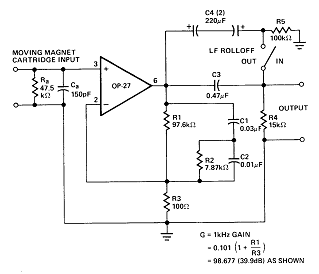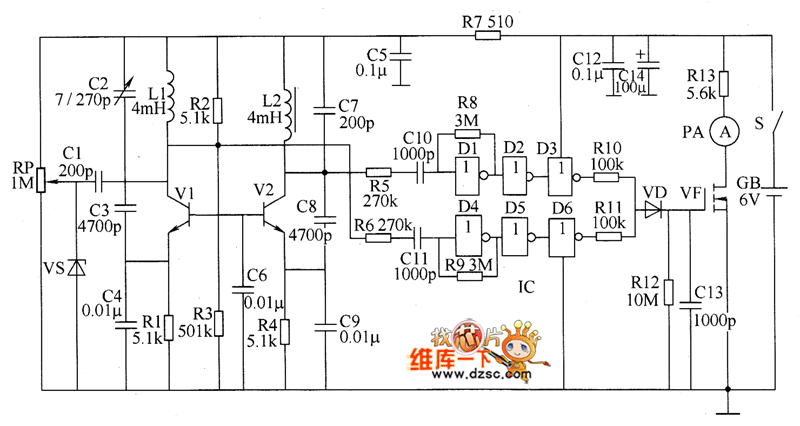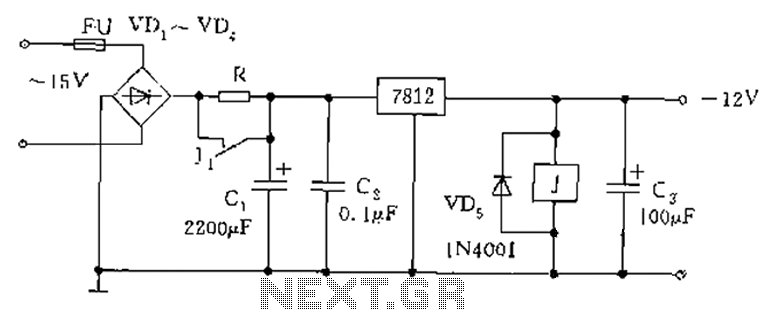
LED ramping circuit

In this circuit, the intensity of the LED varies in a ramping fashion. The circuit comprises three integrated circuits: two 555 timer ICs and one LM393 operational amplifier. IC1 and IC2 are configured as oscillators to generate frequencies of 10 kHz and 1 Hz, respectively. These frequencies are fed into the inputs of the LM393 op-amp, which is configured as a comparator. The output of the LM393 produces a PWM signal that controls the field-effect transistor (FET) Q1, driving the LED. Consequently, the LED gradually increases from an OFF state to full brightness and then slowly fades back to the OFF state, with this cycle repeating. The resistor R4 regulates the current flowing through the LED.
This circuit effectively utilizes the 555 timer ICs to create a dual-frequency output necessary for modulating the brightness of the LED. The first 555 timer (IC1) generates a high-frequency square wave at 10 kHz, which is essential for rapid switching, while the second timer (IC2) produces a low-frequency square wave at 1 Hz, which dictates the overall modulation speed of the LED brightness.
The LM393 operational amplifier acts as a comparator, receiving the outputs from both timers. The comparator's role is to compare these two frequency signals and generate a pulse-width modulation (PWM) output. This PWM signal varies in duty cycle, which directly influences the average power delivered to the LED.
Field-effect transistor Q1 is employed to handle the higher current required by the LED. The PWM signal from the LM393 controls the gate of Q1, allowing it to switch the LED on and off rapidly. The result is a smooth transition in brightness, as the LED ramps up to full brightness and then dims back to OFF. The time constants of the 555 timers, along with the resistor R4, can be adjusted to fine-tune the LED's brightness ramping speed and overall current flow, ensuring optimal performance and longevity of the LED.
This circuit design is particularly useful in applications requiring visual indicators with gradual brightness changes, such as in decorative lighting, automotive lighting, or user interface elements in electronic devices.In this circuit the intensity of LED will vary in a ramping fashion. The circuit consists of three ICs: Two 555 timer ICs and one LM393 op-amp. IC1 and IC2 are wired as oscillators to produce 10 KHz and 1 Hz frequencies respectively. These two frequencies are given to the inputs of the op-amp LM393. LM393 is wired as a comparator and its output will be a PWM signal. This PWM signals controls the FET Q1 to drive the LED. The LED will rise from OFF state to full brightness slowly and then slowly fades to OFF state and this operation repeats. The resistor R4 controls current through the LED. 🔗 External reference
This circuit effectively utilizes the 555 timer ICs to create a dual-frequency output necessary for modulating the brightness of the LED. The first 555 timer (IC1) generates a high-frequency square wave at 10 kHz, which is essential for rapid switching, while the second timer (IC2) produces a low-frequency square wave at 1 Hz, which dictates the overall modulation speed of the LED brightness.
The LM393 operational amplifier acts as a comparator, receiving the outputs from both timers. The comparator's role is to compare these two frequency signals and generate a pulse-width modulation (PWM) output. This PWM signal varies in duty cycle, which directly influences the average power delivered to the LED.
Field-effect transistor Q1 is employed to handle the higher current required by the LED. The PWM signal from the LM393 controls the gate of Q1, allowing it to switch the LED on and off rapidly. The result is a smooth transition in brightness, as the LED ramps up to full brightness and then dims back to OFF. The time constants of the 555 timers, along with the resistor R4, can be adjusted to fine-tune the LED's brightness ramping speed and overall current flow, ensuring optimal performance and longevity of the LED.
This circuit design is particularly useful in applications requiring visual indicators with gradual brightness changes, such as in decorative lighting, automotive lighting, or user interface elements in electronic devices.In this circuit the intensity of LED will vary in a ramping fashion. The circuit consists of three ICs: Two 555 timer ICs and one LM393 op-amp. IC1 and IC2 are wired as oscillators to produce 10 KHz and 1 Hz frequencies respectively. These two frequencies are given to the inputs of the op-amp LM393. LM393 is wired as a comparator and its output will be a PWM signal. This PWM signals controls the FET Q1 to drive the LED. The LED will rise from OFF state to full brightness slowly and then slowly fades to OFF state and this operation repeats. The resistor R4 controls current through the LED. 🔗 External reference





